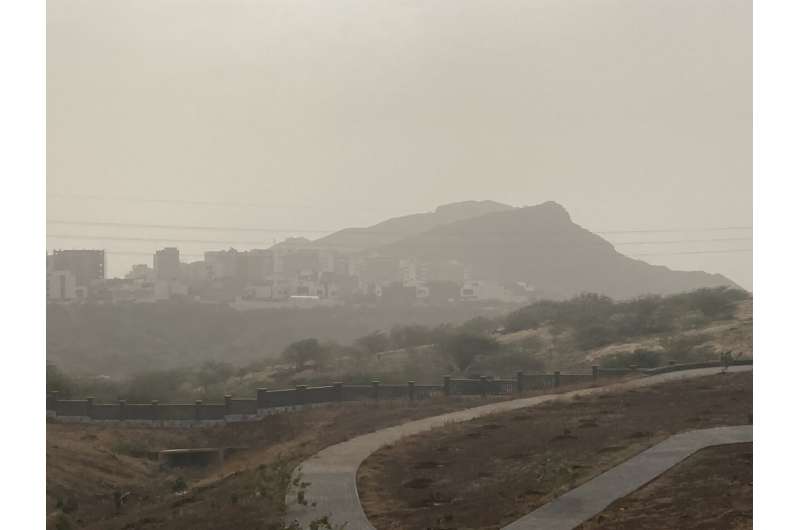African dust crosses the Atlantic

A beautiful sunset over the Atlantic off the Florida coast, or an orangey glow in the Texas sky at dusk may be caused by dust from West Africa, according to researchers who are looking at the paths of particulate matter in the skies over the Sahara desert and the semi-arid Sahel.
"We are looking at how much dust is being transported into West Africa in the winter and across the Atlantic in the summer," said Gregory S. Jenkins, professor of meteorology and atmospheric science, geography, and African studies, Penn State. "In the winter, it is low in the atmosphere and in the summer, it is higher in the atmosphere. Dust has an impact, especially on health."
Jenkins and Moussa Gueye, research professor, University of SIne Saloum El-Hȃdj Ibrahima NIASS, Dakar, Sénégal, modeled annual particulates less than 10 microns (PM10) from 1960 to 2016.
"We showed that there is a simulated annual downward trend in surface PM10 concentrations in Senegal and Cabo Verde after the 1980s, which is similar to earlier findings," the researcher report in Atmospheric Environment. However, the data for summers suggests that there was an increase in dust over the Western Sahara that was transported to Cabo Verde suggesting that this Eastern Atlantic dust continued on toward the U.S. and the Caribbean.
The researchers can measure the amounts of dust that reach the Western Atlantic near Miami, Barbados and Puerto Rico for example, because there are ample meteorological and other measurement stations in those areas, but in West Africa and places like Cabo Verde, there are few ground-based measurement facilities to measure the dust reaching there.

Researchers must then rely on satellite-based measurements, which cannot provide measurement at night. The data collected by ground-based and satellite instruments is used as the basis for models that estimate the paths and amounts of dust hitting West Africa in the winter and the Atlantic and Caribbean in the summer. However, there are so few measurement stations in Africa—because the stations require electricity, cell phones, internet and someone to maintain them—that the models are somewhat incomplete.
"With the very limited measurements we have from West Africa compared to our measurement, we run the models and provide estimates," said Jenkins. "We know that the model timing is correct, but we don't know how much the few stations we have are biasing our results."
According to Jenkins, currently, the best system is in Nigeria where the stations are 25% less costly, but they still need reliable electricity and internet. He notes however, that Cabo Verde does have reliable Wi-Fi and he would like to put particulate matter stations on each of the islands.
According to Jenkins, the model simulations reproduce the trends seen in the past, however, none of the models simulate the dust correctly. Knowledge of exactly where the dust is going at any time and how much dust exists at the ground level is important. Estimates suggest that West Africa will have a population of a billion by 2070. Because this dust in the air can cause respiratory problems and may carry pathogens, knowing when to stay out of the dust is important.

"The dust will have lots of impact in West Africa," said Jenkins. "But in the U.S., we also want to know what happens in the future. I think there is good reason to say there will be more dust in the future."
Jenkins would like to build a particulate matter system across Africa so that there are sufficient data to refine the models. The system would also be able to warn people with, for example, asthma, when to stay inside.
One concern of the researchers is that they know that this Saharan dust transport may change because of climate change in the future.
More information: Gregory Jenkins et al, Annual and early summer variability in WRF-CHEM simulated West African PM10 during 1960–2016, Atmospheric Environment (2022). DOI: 10.1016/j.atmosenv.2022.118957
Journal information: Atmospheric Environment
Provided by Pennsylvania State University





















